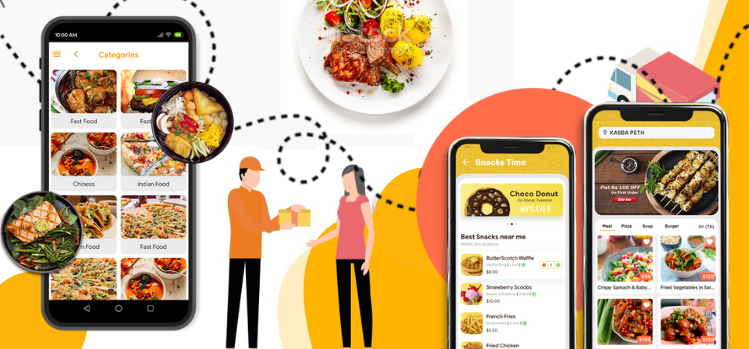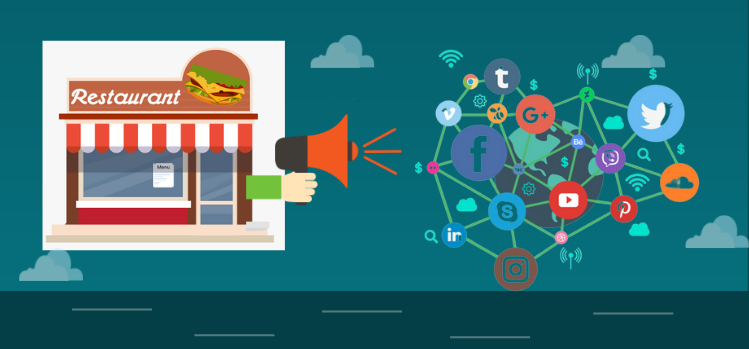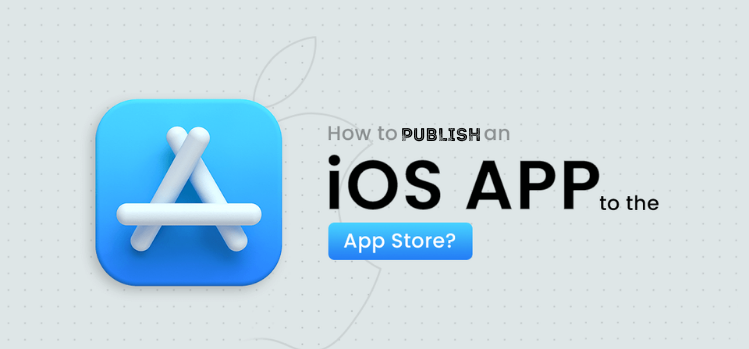How to Start a Food Delivery Business
If you are reading this in 2022, chances are high, that you must have ordered food online at least once in the last week. You must have encountered a Zomato or a Swiggy delivery guy on your way to work today. Such has been the level of penetration of the food delivery business in India and across the world, that you won’t find a mobile phone without at least 1 food delivery app installed on it.
According to Boston Consulting Group (BCG), India’s online food ordering market is expected to grow at an extraordinary annual growth rate of 30 to 35%. This trajectory will propel the market size to touch $7.5- $8 Billion by 2022. This phenomenal growth has motivated new start-ups, SMEs, and entrepreneurs to invest in food delivery apps across the country. If you are one such entrepreneur who is looking to start a food delivery business in India. Then this article is just for you.
Did you know –
1,231.9 million people were using food delivery services in 2020. This number is likely to triple by end of 2025.
In this article, I will provide a step-by-step approach to How to start a food delivery business in India.
Research – Finding the Gap in the current market
First and foremost, you will have to research the current market. Conducting thorough research is key to understanding market dynamics and building a suitable entry strategy. Both primary and secondary research can come in handy. You can start by researching your local area, and community, then move on to the internet, competitors, partners, etc.
Knowing your market increases the chance of success for any business.
Points to consider :1. Competitor Business models. – The food delivery service market is fairly new, so you will see a variety of business models. Check how many current players are there in the market? How many of them are platform-to-consumer? and how many are restaurant-to-consumer? what about the delivery logistics? Are competitors using their own delivery fleet or leveraging on the restaurant? What are the pros and cons for both? Which one pis cost-effective? You can also study the pricing patterns, online menus, and market strategies of these players. All this information will give you a definite edge when you will start your food delivery business.
2. Profit sharing, Commissions – One area you must research is what is the current profit-sharing model between food delivery businesses and restaurants? What are the commissions earned? What are the delivery fees? How many parties are involved from order taking to final delivery? This information helps you refine your planning. It also helps you arrive at a more realistic sense of expected revenue, profitability, and potential leakages. This will also help you plan your supply chain more efficiently.
3. SWOT – It might seem academic but performing a SWOT analysis (Strength, Weakness, Opportunity, and Threat) to compare key aspects of your business vis-à-vis your competitors and the current market is a very effective tool. The analysis will help you identify your strengths, it will throw up some weaknesses which you didn’t realize when deciding to start. It will show you some new opportunities to consider and recognize threats.
4. Market gaps – This will be the final result of your research. With all the data and insights that you have gathered, you can finally arrive at the current market gap. An untapped, unattended consumer section or consumer demand will emerge. You could also detect an inefficient supply problem that can be solved or a pricing block that can be explored.
You are now ready to start your food delivery business journey.
Audience – Who is your target audience.
The other important aspect of research is finding out the demographics of your audience. What is the age group, occupation, lifestyle, and cultural background? Every consumer segment has its unique characteristics.
Knowing your consumer segment enables you to uncover valuable audience insights. It can help dictate the content, targeting, and media buying strategy of your marketing campaigns. It allows you to understand which audiences exist, whom to target and why. It gives you awareness on the most effective way to reach them.
Based on the research you’ve conducted; you can decide if you’d like to cater to a particular consumer segment or multiple.
Online food ordering is almost always an impulse decision. Customized targeting plays a crucial role in consumer engagement, leading to subsequent order placement, and resulting in revenue. When a group of customers is sent personalized messages as part of a marketing mix that is designed around their needs, it’s easier for companies to send those customers special offers meant to encourage them to order more.
Understanding these factors will also determine the kind of demand, the purchasing capacity, and the food preferences of the consumer. Which in turn will help you determine your investment, your marketing strategy, and the meals that you offer. For example – You may tweak your delivery menu based on the preferences of your target audience(s). Families might be interested in home cooked healthier food options, while students might want a quick meal and snack options that are not too expensive.
Customer segmentation will also most certainly improve customer service and assist in customer loyalty and retention.
Did you know –
According to campaign monitor, segmented marketing campaigns increase revenue by 760%.
Requirements – Getting the paperwork done
While starting a business is exciting, fun, and stimulating, unfortunately, it also has some uninteresting elements such as well. Legal procedures and paperwork can seem daunting and intimidating, however, this is because not everyone is ready to get into the details of it.
You must have a comprehensive understanding of the various legal paperwork and procedures that a food delivery business needs. Once you understand them, then it’s just a matter of follow-up.
Some must-haves that need to be in place
1. Registration of your business – Registering your business as a separate legal entity is the first step. This is important to protect your personal assets. You can choose from many different types, such as an LLC, Corporation, or DBA. For your business to be treated as a separate entity, it should have a name, a GST number, a Pan Card, and Residence proof. Check with your local registration office to get a complete list of documents.
2. Licenses – When dealing with food, there are several licenses that the govt of India specifies a business should have. Some of these include licenses like the FSSAI license that ensures the safety and quality of food products in India. Next is a shop act license, health trade license, signage license, eCommerce agreements, etc. An exhaustive list would be available on the govt website.
3. Bank account: Since your business is a separate entity, it is required to have a separate banking relationship. This means a separate current account under its name, a credit line if you are eligible. This again is important to both for an audit purpose as well to protect your personal assets. It also makes filing your taxes easier. Also, be sure to set up an accounting system to understand your finances and be ready to file taxes annually.
4. Insurance: This is an often-overlooked aspect. Any business carries risk, A food delivery business even more so. Just look at the risks involved First of all, there are so many parties involved. The food changes hands so many times. Then there are the delivery folks who ride bikes in heavy traffic. To protect yourself from liability risks and unexpected out-of-pocket expenses, it is prudent to consider the following insurance schemes. Third party injury, property damage, personal injury, and group medical.
The above list is not exhaustive by any means, but it is good enough to get you started. Having paperwork done in advance is a real-time saver. It also helps you focus on more important aspects of growing your business.
Investment – Understanding the costs involved.
It is common knowledge that starting a new business is always a capital-intensive process. In your research, apart from finding the market gap and target audience, you would also get a fair idea of how much investment is required to run a successful food delivery business.
It is essential to categorize your investment as must-haves and good-to-haves. Let’s discuss some of the major must-have investments required to run a food delivery business in India.
1. Mobile app development expenses – This will be your biggest expense, as it is the heart and soul of your business. As discussed before a well-curated mobile application can make or break your business. As an entrepreneur, you would be investing both money and time into developing this. A great piece of advice is partnering with food delivery application development companies. Having an expert handle the most critical aspect of your business means you get what you want, when you want and more importantly it saves you from any unwanted surprises.
A food delivery app usually consists of 3 applications.
- a) Customer-facing app – this is the main application that the customer downloads and orders from.
- b) Supplier-facing app – This is the secondary application, this is for the restaurants to manage orders, delivery, and payments.
- c) Administration app – This is for ease of operations and handling various administrative tasks, approvals, discounts, etc.
The more features you include the more attractive the application, however, it also means the more costly it gets for you. Features like tracking, account creation, images, product descriptions, how-to recipes, etc are standard across all food delivery apps today.
2. Software purchase/subscription – Apart from a mobile app, you will also need to either purchase software or purchase a subscription to the software. Customers will most likely pay online via Debit, Credit, Internet banking, or UPI. You will need Point-of-sale (POS) software to collect online payments. There are various software vendors in the market that give this service at different rates. The other software that is a basic requirement is GPS tracking apps (to track deliveries). The more features you want to add to your application. The costlier these software purchases get.
3. License cost – All the paperwork and licenses mentioned in the above point, many of them need to be purchased. Registration, trademark, FSSI, and Domain name all come with a cost element attached.
4. Logistics costs – If you let the restaurants handle the packaging then your primary cost of logistics will come down to your delivery fleet. If your business model is to have your own delivery fleet, then it means you have to recruit and train individuals and provide them salaries, incentives, uniforms, basic employment benefits, insurance, etc. Depending upon the area you plan to cover, it is needless to say this means an extremely high investment initially. You can also choose to use the restaurant’s own delivery fleet. But it comes with the disadvantage of having lesser control.
5. Marketing expenditure – Finally, you’ll need to set aside a budget for marketing your business. Right from innovative brand-building exercises and campaigns to the more orthodox email marketing, pamphlets, hoardings, and participation in events. Everything will need careful planning, execution, and unhinged budgeting.
Since initially since your brand is not well established, the brand setup cost will be high. Subsequently, the budgets can be more standard and follow a linear pattern.
Did you know –
That 60% of the consumers that order Food Delivery through apps are millennials
Network - Set up a strong delivery network
A strong and agile delivery network is the backbone of any food delivery business. In today’s market, where 10 min delivery is the new normal, it is vital to have a delivery fleet that has the experience and is reliable.
Food delivery relies on four things: structure, people, processes, and technology. Your approach to these elements will change based on how you plan to start. If you want to start food delivery within a smaller radius and only a handful of restaurants, then the size and complexity of your operation are fairly low. This means the number of people, the delivery structure as well as the processes and technology can be managed easily. However, if you plan to start big then these elements become challenging.
There are two ways to tackle the delivery challenge.
- a) Hire your own delivery fleet
- b) Leverage trusted partners
Both options have their advantages and disadvantages.
While hiring your delivery fleet gives you greater control of your deliveries and helps you maintain a certain standard, it is also a big-ticket item at your cost.
By tying up with a partner you let go of control. But in return ensure cost-effectiveness which end of the day translates into better pricing for the customer as well as greater revenues for you.
We recommend that you tie up with hyperlocal delivery partners like SARAL that provide you the cheapest rates and bring to you partners like Dunzo, Wefast, and Shadowfax on one platform. Such partners can give you competitive pricing since they leverage their fleet and work on economies of scale.
Since these providers are already trained for hyperlocal deliveries, you do not need to invest anything extra in training. It provides you with a vast delivery network at zero additional investments.
A good to have element is something called a Route optimization software. This enables you to track the fleet in real-time, gain visibility over operations, and view estimated times of arrival.
Did you know –
According to delivery statistics, two-thirds of customers don’t want to wait more than 40 minutes for their food to arrive. More than that, you risk a drop in your rating.
Building a Brand – Online and Offline
While building your brand, the first question you need to ask yourself is why should a consumer choose you? when he/she has so many options? What is so unique about your business? It might be anything. It could be the variety of choices that your food delivery app offers, the market gap that you identified, the delivery time, or a niche audience segment that you are catering to.
When you find out what makes your food delivery business different from the rest. That one aspect becomes your USP, around which you can build your branding.
The next step after brand identification is building and establishing your presence. Before you start any marketing or promotional campaign, it is imperative to ensure that your food delivery business is present both online and offline.
Establishing an offline presence is straightforward. Apart from putting up hoardings, distributing flyers, and cultivating local tie-ups, it is your delivery fleet that is on the road wearing your company uniform that will give you maximum offline coverage.
Online marketing however is tricky. Depending upon the budget, the USP, and target audience, one can explore various spheres of an online presence
Apart from the app, it is good to have a website with similar functionality. Your website can be an extension of your app and have more pages eg – an About Us page, and Investor page, and a career page. You can also add blogs, a recipe page, a contact page, etc.
The other aspect of online presence is creating your social media persona. The impact of social media platforms in our lives has been undeniable. It is a place where identity and narratives are formed. Any person/page/brand that has a substantial following can persuade and influence a large group of people.
Presence on these sites is paramount if you are serious about building trust and long-term relationships with your customers. The most popular among them are Facebook and Instagram. However, platforms like Twitter, YouTube, and even LinkedIn are becoming more and more influential
You can start by creating a page (Facebook) or creating an account (Instagram) for your business. Fill the profile section with as much detail as possible. Pictures and videos will give you that added advantage since audio-visual content is much easier to consume. The most basic function of your social media presence is to create awareness about your brand. However, you can use this medium to a much greater effect, if you are willing to put in the effort. Engaging on social media will allow you to talk to consumers and give them something beyond the food delivery experience. By commenting on posts, sharing photos of food and staff, videos of recipes, and putting out exclusive offers. You create a community that expands far beyond a mere food delivery app.
A good example of this is Zomato which has a Youtube channel where it interviews celebrities. It’s highly engaging and consumable content that also promotes the brand.
Once you reach a substantial number of followers, your social media communication will start driving real value. You can use it to promote an event, discount coupons, a new subscription model, etc.
Did you know –
Zomato said it clocked over Rs 100 crore in gross merchandise value (GMV) on a single day on 31st December last year— GMV indicates the value of food ordered on its platform.
Marketing and Customer care
So, you have identified your niche segment, taken care of the licenses, got yourself a strong delivery network, and set up your online and offline presence. Now, it‘s time to market your brand.
Simply put, good marketing is knowing how to leverage your online and offline presence effectively. There is no right or wrong way to market a food delivery business. The idea is to get your brand identity in place and do the basics right. Once you are done with those, then keep experimenting based on the latest trends, Innovations, and interests. Communication and engagement will act like oxygen, keeping your brand relevant.
Some must-have marketing elements are as follows
1. Subscription system – One tried and tested marketing strategy to increase consumer retention and stickiness with your food delivery app is to offer a subscription option to the consumer. While he can download and use the app for free. He/she also has an option to pay a nominal amount. This will give the consumer an upgraded status and he/she will be eligible for various perks eg –as free delivery, better discounts, and offers. Eg- Zomato has Zomato Pro, Swiggy has Swiggy One. This not only acts as a customer engagement marketing approach but also a constant revenue generator for your company.
2 Customer care – Grievances handling is perhaps the most underrated aspect of running a food delivery business. Food invokes an emotional reaction amongst many of us, this is why consumers react critically at the slightest delay or drop in quality. A well-trained, experienced customer care team is, therefore, an indispensable cog in the well-oiled machinery of the food delivery business that we discussed today. Like many things, customer care to has moved from a traditional on-call model to a social media model. Consumers prefer to express themselves on social media than anywhere else. Many food delivery apps have a dedicated social media handle eg – Zomato cares, and Swiggy cares which scouts social media for any bad reviews and responds immediately to the consumer. This ensures minimal damage and quick resolution. Even in terms of SEO, the quantity and quality of reviews impact how high you rank across all search results. The content of those reviews can also make for excellent marketing material.
3. Merchandize – Branded merchandise such as delivery team uniforms, caps, t-shirts, sweatshirts, cups, cup holders, books, tea coasters, tot bags, etc are all marketing materials used to promote your food delivery business services. These merchandized materials are known as promotional products. You might distribute these products with certain orders or to upgraded consumers free of cost to create brand awareness.
4. Blogs – Last but not the least Blogs, Blogs are still one of the most effective digital marketing tools available. They provide relevant information, raise brand awareness, and more importantly engage the consumer. Blogging about various food-related topics, recipes, and other useful information you can create a sense of trust among the consumers. Consumers are more likely to visit your blog and share your blog with others if they find value. Google will recognize your website as a lead authority if you have expert knowledge on a subject. If you present relevant and valuable content, regardless of the size of your company, you will rank higher on SERPs. Blogs also enhance your SEO.
All these aspects will add the much-needed zing to your overall marketing strategy, making it easier for you to communicate what you want and how you want with your intended audience.
Conclusion
While it is a well-known fact that the food delivery market is going at a rapid pace, there is also no denying the fact that big players such as Swiggy, and Zomato constitute the largest market share. Customers are also used to such apps and it may seem that there is no point in entering such a saturated market as an entrepreneur. However, if you have an innovative idea, or have identified a niche segment then there is certainly a way to jump into the market and reap the benefits of the growing sector.
Having a simple, user-friendly, intuitive mobile application goes a long way in ensuring success in this field. As it becomes the key differentiator in a market full of food delivery players. One sure-shot way to make your food delivery business app successful is to find the right technology vendor who can carry your idea thru to its end.
If you are a beginner or are clueless about the latest technologies, functionalities, and features you can integrate into your app, then it is best to hire an app developer and discuss your business plan to customize the app with the best features.
Here is a list of some of the best Food delivery application development companies in India.









Add comment